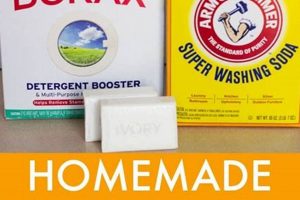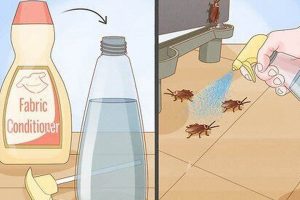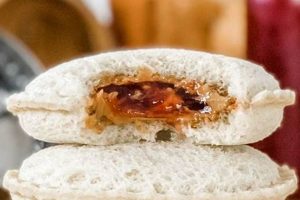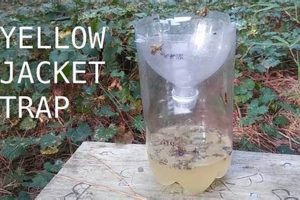A homemade solution designed to eliminate odors embedded within carpet fibers is a commonly sought alternative to commercially manufactured products. This type of preparation typically involves readily available household ingredients and aims to neutralize unpleasant smells without the potentially harsh chemicals found in store-bought deodorizers. For example, a mixture of baking soda and essential oils can be applied to carpets to absorb and mask malodors.
The practice offers several advantages, including cost-effectiveness and the ability to control the ingredients used, making it a favorable option for individuals with sensitivities or concerns about environmental impact. Historically, the use of natural substances for cleaning and odor control predates the widespread availability of synthetic chemicals, reflecting a renewed interest in traditional, sustainable practices. The benefits extend to reducing exposure to potentially harmful chemicals, customizing scents, and minimizing waste by repurposing existing household items.
The subsequent discussion will focus on the formulation and application of these homemade solutions, exploring various ingredient combinations, methods of application, and considerations for different carpet types to achieve optimal odor elimination.
DIY Carpet Deodorizer
The effective use of homemade solutions for carpet odor elimination necessitates careful consideration of several factors. The following tips outline key aspects to ensure optimal results and prevent potential issues.
Tip 1: Ingredient Selection: Opt for high-quality ingredients. Pure baking soda is a common base, while essential oils should be therapeutic grade to ensure potency and avoid synthetic additives that may exacerbate sensitivities.
Tip 2: Pre-Vacuuming: Thoroughly vacuum the carpet prior to application. This removes loose debris and surface dirt, allowing the deodorizer to penetrate the fibers effectively.
Tip 3: Even Distribution: Employ a sifter or shaker to evenly distribute the mixture across the carpet. Uneven distribution can lead to clumping and difficulty in vacuuming.
Tip 4: Dwell Time: Allow sufficient dwell time for the deodorizer to absorb odors. A minimum of 30 minutes is recommended, with longer dwell times (several hours or overnight) for persistent odors.
Tip 5: Thorough Vacuuming Post-Application: After the dwell time, vacuum the carpet thoroughly to remove all traces of the deodorizer. Multiple passes may be required to ensure complete removal.
Tip 6: Spot Testing: Prior to full application, conduct a spot test in an inconspicuous area to assess potential discoloration or adverse reactions, particularly on delicate or antique carpets.
Tip 7: Addressing Underlying Issues: Identify and address the source of the odor. Simply masking the smell will not provide a long-term solution if underlying issues, such as pet urine or mold, are not resolved.
Tip 8: Ventilation: Ensure adequate ventilation during and after application. Open windows or use fans to promote airflow and expedite drying.
Following these guidelines can significantly improve the effectiveness of homemade carpet deodorizers, ensuring a cleaner, fresher environment while minimizing potential risks.
The subsequent section will delve into specific formulations and application techniques for addressing various types of carpet odors.
1. Baking Soda Base
Baking soda (sodium bicarbonate) serves as a foundational element in many homemade carpet deodorizing formulations. Its inherent properties make it a versatile and effective ingredient for absorbing and neutralizing odors embedded within carpet fibers.
- Odor Absorption Mechanism
Baking soda’s porous structure allows it to physically absorb odor molecules, effectively trapping and encapsulating them. This mechanism differs from simply masking odors with fragrances; instead, it addresses the root cause of the problem. For example, in cases of pet urine, baking soda can absorb the ammonia compounds responsible for the characteristic smell.
- pH Neutralization
Baking soda exhibits a slightly alkaline pH, which can help neutralize acidic odors commonly found in carpets. This is particularly relevant for addressing smells caused by spilled food or beverages. The neutralization process alters the chemical structure of the odor-causing compounds, rendering them less volatile and therefore less noticeable.
- Safety and Environmental Considerations
Compared to many commercially available carpet deodorizers containing synthetic chemicals, baking soda presents a safer and more environmentally friendly alternative. It is generally non-toxic and poses minimal risk of irritation or allergic reactions for humans and pets. Its biodegradability also reduces its environmental impact.
- Versatility and Complementary Ingredients
Baking soda acts as an excellent base for incorporating other odor-fighting and fragrance-enhancing ingredients. Essential oils, for instance, can be added to baking soda to provide a pleasant scent and potentially offer antimicrobial benefits. The combination creates a multi-faceted deodorizing solution tailored to specific needs and preferences.
The multifaceted properties of baking sodaodor absorption, pH neutralization, safety profile, and versatilityestablish it as a cornerstone ingredient in effective homemade carpet deodorizing strategies. Its ability to address odors at their source, coupled with its safety and environmental advantages, solidifies its position as a preferred choice for individuals seeking a natural and reliable solution.
2. Essential Oil Choice
The selection of essential oils represents a critical component in the formulation of homemade carpet deodorizers, influencing both the efficacy and the sensory experience of the product. The relationship between essential oil choice and the overall performance of a DIY deodorizer extends beyond simple fragrance enhancement; specific oils possess inherent antimicrobial, antifungal, and odor-neutralizing properties that can actively contribute to a cleaner and fresher carpet environment. For example, tea tree oil, known for its potent antifungal qualities, can be incorporated to address mold-related odors, while lemon oil offers a refreshing scent and demonstrates effectiveness against grease and grime. The choice, therefore, is not merely aesthetic but functional, dictating the solution’s capacity to tackle specific odor challenges.
Practical application necessitates a nuanced understanding of essential oil properties and their potential interactions with carpet fibers and other cleaning agents. Certain oils, while possessing desirable odor-fighting characteristics, may cause discoloration or dam
age to delicate carpet types. A patch test in an inconspicuous area is therefore crucial prior to full application. Furthermore, the concentration of essential oil used is a determinant factor; excessive amounts can lead to overpowering scents or potential irritation, while insufficient quantities may render the deodorizer ineffective. Proper dilution and blending techniques are essential to achieving optimal results. Lavender oil, for instance, is commonly used for its calming scent and deodorizing capabilities, but requires careful dilution to prevent residue build-up on the carpet fibers.
In summary, essential oil choice is a pivotal element in crafting effective homemade carpet deodorizers. A thoughtful approach, grounded in knowledge of essential oil properties, carpet compatibility, and appropriate application techniques, is paramount. The successful integration of essential oils transforms a simple deodorizing agent into a tailored solution that not only eliminates unwanted odors but also contributes to a healthier and more pleasant living environment. Overlooking this component can lead to ineffective results or potential damage, highlighting the practical significance of informed decision-making in DIY cleaning practices.
3. Pre-Vacuum Importance
Prior to the application of any homemade carpet deodorizing agent, the step of pre-vacuuming assumes paramount importance. This preparatory action significantly influences the efficacy of the subsequent deodorizing process, ensuring optimal penetration of the deodorizer and preventing interference from surface-level debris.
- Enhanced Deodorizer Penetration
Pre-vacuuming removes loose dirt, dust, and pet hair from the carpet surface. This clearance allows the homemade deodorizer, typically a powder-based mixture, to directly contact the carpet fibers where embedded odors reside. Without this step, the deodorizer primarily interacts with the surface debris, reducing its ability to neutralize deeper odors.
- Prevention of Caking and Clumping
The presence of moisture or sticky substances on the carpet can cause the dry deodorizer to clump and cake upon application. Pre-vacuuming removes these potential binding agents, enabling a more even and consistent distribution of the deodorizing powder. This even distribution is critical for uniform odor absorption across the carpet surface.
- Improved Vacuuming Efficiency Post-Treatment
Post-deodorizing, thorough vacuuming is essential to remove the remaining powder and absorbed odors. Pre-vacuuming reduces the overall volume of debris that must be extracted during this final vacuuming phase. This streamlined removal process minimizes the risk of clogging the vacuum cleaner and ensures a more effective extraction of the deodorizing agent.
- Minimizing Abrasive Damage
Debris trapped within carpet fibers can act as an abrasive during the application and vacuuming of a homemade deodorizer. This abrasive action can potentially damage or wear down the carpet fibers, especially with repeated treatments. Pre-vacuuming removes this potential source of abrasion, helping to preserve the integrity and appearance of the carpet over time.
The integration of pre-vacuuming into the routine application of homemade carpet deodorizers is not merely a perfunctory step. Rather, it represents a fundamental element in maximizing the effectiveness of the deodorizing treatment, ensuring uniform application, and safeguarding the long-term condition of the carpet. Its omission compromises the potential benefits of the deodorizer and increases the risk of suboptimal results.
4. Even Application
Even application is a critical determinant of the success of any homemade carpet deodorizing endeavor. Uneven distribution of the deodorizing agent can lead to inconsistent odor elimination and potential aesthetic issues within the treated carpet area.
- Uniform Odor Neutralization
When a deodorizing mixture is applied unevenly, areas with a higher concentration of the product will experience more effective odor neutralization than areas with insufficient coverage. This results in a patchy outcome, where some sections of the carpet remain malodorous while others are adequately deodorized. The objective is a uniformly fresh carpet, achievable only through even application.
- Prevention of Residue Build-Up
Over-application of a homemade deodorizer in certain areas can lead to a build-up of residue within the carpet fibers. This residue may attract dirt and grime, potentially worsening the original problem and creating a visible discoloration or change in texture. Even application minimizes the risk of localized residue accumulation.
- Optimal Vacuuming Efficiency
Uneven application necessitates more focused and potentially repetitive vacuuming efforts to remove the deodorizing agent completely. Areas with excessive product require more passes with the vacuum cleaner, increasing the time and effort required for the cleaning process. Even distribution ensures a more streamlined and efficient post-application vacuuming routine.
- Minimizing Carpet Fiber Damage
Aggressive vacuuming aimed at removing concentrated deposits of deodorizing powder can potentially damage carpet fibers. The friction and pressure exerted by the vacuum cleaner on heavily treated areas can lead to fiber wear and tear, particularly with repeated cleanings. Even application reduces the need for such aggressive vacuuming, minimizing the risk of damage.
The multifaceted benefits of even application underscore its significance in the context of homemade carpet deodorizing. From ensuring consistent odor elimination to preventing residue build-up and minimizing potential damage to carpet fibers, the principle of even distribution is paramount. Its proper implementation ensures a more effective, efficient, and aesthetically pleasing outcome, solidifying its role as a cornerstone of successful DIY carpet care.
5. Adequate Dwell Time
The effectiveness of any homemade carpet deodorizing solution hinges significantly on allowing sufficient dwell time. Dwell time refers to the period the deodorizing agent remains in contact with the carpet fibers, facilitating the absorption and neutralization of odor molecules. Insufficient dwell time compromises the deodorizer’s ability to fully penetrate the fibers and address embedded odors, resulting in a superficial treatment and limited long-term odor control. For instance, baking soda, a common ingredient, requires extended contact to effectively absorb odors from pet urine or spilled liquids. A brief application followed by immediate vacuuming provides minimal benefit, as the baking soda has not had sufficient opportunity to interact with the odor-causing compounds.
Practical applications underscore the importance of extended dwell times. For general deodorizing purposes, a minimum of 30 minutes is often recommended. However, for more persistent or severe odors, such as those caused by mold or mildew, dwell times of several hours or even overnight may b
e necessary to achieve satisfactory results. The type of carpet fiber also influences the optimal dwell time; thicker, more densely packed fibers may require longer contact periods to ensure thorough deodorization. Spot testing in an inconspicuous area is advisable to assess potential discoloration or adverse reactions, particularly when employing extended dwell times or using essential oil-based deodorizers. Failure to provide adequate dwell time represents a common pitfall in DIY carpet deodorizing, leading to frustration and the perception that homemade solutions are ineffective.
In conclusion, adequate dwell time constitutes a non-negotiable element in successful homemade carpet deodorization. It directly affects the degree to which odors are neutralized and the longevity of the deodorizing effect. While specific dwell times may vary based on the nature and severity of the odor, the type of carpet, and the ingredients used in the deodorizer, prioritizing sufficient contact time is crucial. Overlooking this aspect undermines the potential benefits of DIY deodorizing, rendering the effort largely ineffective. Understanding and implementing proper dwell time protocols transforms homemade carpet deodorizers from mere superficial treatments to potent odor-eliminating solutions.
6. Post-Vacuum Removal
Effective post-vacuum removal is intrinsically linked to the success of any homemade carpet deodorizer application. Following the dwell time allotted for odor absorption, thorough vacuuming is essential to extract the remaining deodorizing agent and any encapsulated odor molecules. Insufficient or incomplete removal negates many of the benefits sought through the initial deodorizing process. For instance, residual baking soda, a common ingredient in homemade solutions, can attract dirt and create a dull appearance on the carpet if not fully removed. A high-powered vacuum cleaner equipped with appropriate attachments is therefore necessary to ensure thorough extraction, particularly for carpets with dense or long fibers. Failure to properly remove the deodorizing agent can lead to secondary issues that diminish the overall effectiveness of the DIY treatment.
The practical implications of post-vacuum removal extend beyond mere aesthetics. Unremoved deodorizer residue can potentially trigger allergic reactions or respiratory irritation in sensitive individuals. Furthermore, residual powder can compromise the cleaning performance of subsequent vacuuming efforts, as it may clog filters or reduce suction power. Implementing a systematic vacuuming technique, involving multiple passes in different directions, is crucial to ensure complete removal. The utilization of a vacuum cleaner with HEPA filtration is also advisable to capture fine particles and allergens that may be dislodged during the deodorizing process. Consideration should be given to the type of carpet fiber when selecting vacuum cleaner settings and attachments to prevent damage or excessive wear.
In conclusion, post-vacuum removal represents a critical and often overlooked step in the application of homemade carpet deodorizers. Its effectiveness directly influences the aesthetic outcome, potential for allergen exposure, and the long-term maintenance of the carpet. Proper technique and appropriate equipment are essential to ensure complete removal of the deodorizing agent, maximizing the benefits of the initial treatment and minimizing the risk of adverse consequences. Neglecting this component undermines the overall efficacy of the DIY deodorizing process and can lead to unintended negative impacts on both the carpet and the occupants of the space.
7. Underlying Odor Source
The effectiveness of any DIY carpet deodorizer is fundamentally contingent upon addressing the underlying source of the malodor. Simply masking the symptom, the unpleasant smell, without neutralizing or removing its origin provides only temporary relief and often exacerbates the problem in the long term. A superficial application of a homemade deodorizer will fail to resolve persistent odors emanating from deep within the carpet fibers, padding, or subfloor.
- Pet Urine Contamination
Pet urine represents a common and pervasive source of carpet odors. The uric acid crystals present in urine can embed deep within carpet fibers and padding, requiring specialized enzymatic cleaners to break down and neutralize. A DIY carpet deodorizer, while capable of absorbing surface odors, may prove ineffective in eliminating the deeply ingrained uric acid. Failure to address the urine contamination will result in a recurring odor, even after repeated deodorizing attempts.
- Mold and Mildew Growth
Moisture accumulation, often due to spills, leaks, or inadequate ventilation, can foster the growth of mold and mildew within carpets. These microorganisms generate musty and often pungent odors. DIY carpet deodorizers that lack antimicrobial properties will only mask the smell temporarily, failing to eliminate the underlying fungal growth. This can lead to a cycle of odor recurrence and potential health concerns related to mold exposure.
- Food Spillage and Decomposition
Food particles trapped within carpet fibers can decompose over time, generating foul odors. Depending on the nature of the spillage (e.g., dairy, meat), the resulting odors can be particularly persistent and offensive. DIY carpet deodorizers may provide temporary relief, but the underlying food source must be removed through thorough cleaning and extraction to prevent the odor from returning.
- Subfloor Contamination
In some cases, the source of the odor may reside not within the carpet itself, but in the subfloor beneath. Previous pet accidents, leaks, or mold growth can contaminate the subfloor, leading to odors that permeate the carpet from below. DIY carpet deodorizers applied to the carpet surface will have limited impact in these scenarios, necessitating professional cleaning or subfloor remediation to effectively eliminate the odor source.
Therefore, a comprehensive approach to carpet odor elimination requires careful identification and treatment of the underlying odor source. While DIY carpet deodorizers can serve as valuable tools for freshening carpets and neutralizing surface odors, they should be viewed as a complementary measure to address the root cause of the problem, not as a standalone solution. Failure to do so will result in a persistent odor issue and potentially exacerbate the underlying conditions.
DIY Carpet Deodorizer
The following section addresses common inquiries and misconceptions surrounding homemade carpet deodorizers, providing clarity and guidance for their effective and safe utilization.
Question 1: Will a homemade carpet deodorizer damage my carpet?
The potential for damage depends on the ingredients employed and the carpet fiber type. A spot test in an inconspicuous area is recommended prior to full application to assess compatibility. Abrasive ingredients or harsh chemicals should be avoided.
Question 2: How frequently can a DIY carpet deodorizer be used?
The frequency of application depends on the severity of the odor and the level of foot traffic. Overuse can lead to residue build-up and potential fiber damage. Application should be limited to when necessary to address recurring or persistent od
ors.
Question 3: Are homemade carpet deodorizers safe for pets and children?
While generally safer than commercial alternatives, ingredient selection is critical. Essential oils can be toxic if ingested; therefore, caution should be exercised when pets and children are present during and after application. Thorough vacuuming is essential to remove any residual powder.
Question 4: Can a DIY deodorizer eliminate all types of carpet odors?
The effectiveness of a homemade deodorizer varies depending on the odor source. Surface odors and mild smells are typically more easily addressed. Persistent or deeply embedded odors may require professional cleaning services.
Question 5: What is the optimal dwell time for a homemade carpet deodorizer?
The appropriate dwell time depends on the severity of the odor and the ingredients used. A minimum of 30 minutes is generally recommended, with longer dwell times (several hours or overnight) for stubborn odors. Refer to specific recipe guidelines for optimal results.
Question 6: How should leftover DIY carpet deodorizer be stored?
Unused deodorizer should be stored in an airtight container in a cool, dry place away from direct sunlight and moisture. This prevents clumping and preserves the efficacy of the ingredients.
Effective use of homemade carpet deodorizers requires informed decision-making and adherence to safety precautions. Proper application and removal techniques are crucial to achieving desired results without compromising carpet integrity or the well-being of occupants.
The following section will provide step by step guide.
DIY Carpet Deodorizer
This exploration has illuminated the multifaceted aspects of a homemade solution for eliminating carpet odors. From the fundamental role of baking soda to the nuanced selection of essential oils and the critical importance of proper application and removal techniques, the effective creation and utilization of a do-it-yourself deodorizing agent demands a thorough understanding of both its capabilities and limitations. The underlying principle remains consistent: addressing the source of the odor, not merely masking its presence, is paramount to achieving lasting results.
The implementation of a well-formulated strategy represents a responsible and environmentally conscious alternative to commercially produced chemical treatments. By prioritizing natural ingredients and meticulous application methods, individuals can cultivate a cleaner, fresher living environment while minimizing potential risks to human health and the planet. Continued adherence to best practices and a commitment to informed decision-making will ensure that this process remains a viable and sustainable option for maintaining a healthy home.







